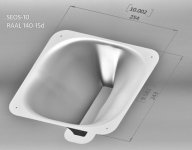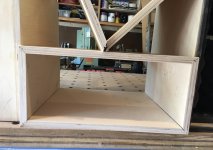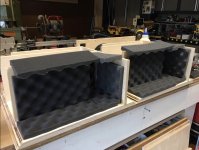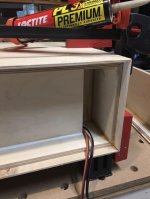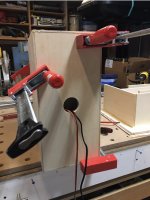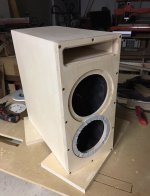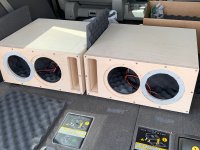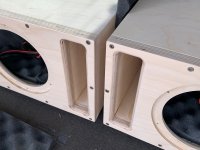He cannot sleep, he still has to finish the Keantoken amp.
The parts for the AurumX amp Front End (FE) are here but a man’s got to know his limitations. I need at least 3 hrs sleep.
I made a new thread for the RAAL and PTT6.5 here:
RAAL 70-20xr and PTT6.5 Compact TL
I also found that a simple change to R2 and C1 and moving tweeter back 2.1in gives a simple Harsch XO:
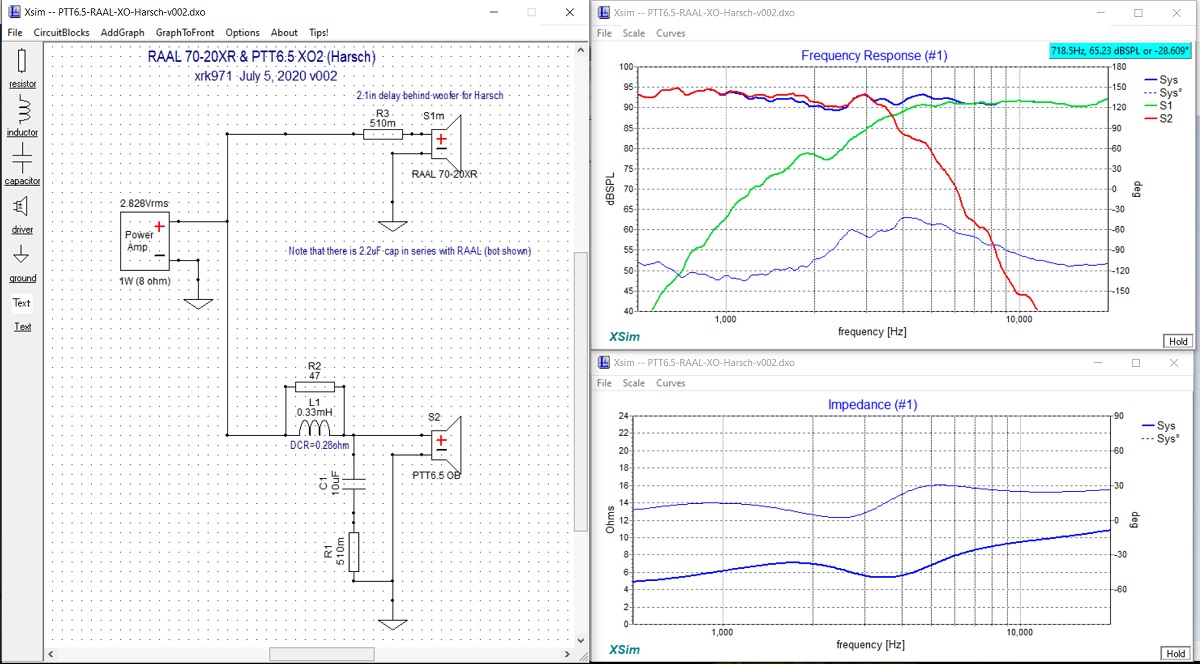
RAAL 70-20xr and PTT6.5 Compact TL
I also found that a simple change to R2 and C1 and moving tweeter back 2.1in gives a simple Harsch XO:
After playing with the speaker for a while the signature of the Ptt6 is starting to show.
My findings are that the bass is deep! Perhaps too deep, which on some material shows as “slow”. This makes me consider if the low tuning of 26Hz is a good choice? The fs of driver is 30Hz.
An example of music which gives too much uncontrolled bass in my system is Carolin No, Still Water Runs Deep.
What do you think about cutting the first internal wall halfway (or all of it). It will raise tuning and give the driver more space to breathe.
Beside this, the overall performance is splendid. Being able to play very loud without any noticeable distortion.
My findings are that the bass is deep! Perhaps too deep, which on some material shows as “slow”. This makes me consider if the low tuning of 26Hz is a good choice? The fs of driver is 30Hz.
An example of music which gives too much uncontrolled bass in my system is Carolin No, Still Water Runs Deep.
What do you think about cutting the first internal wall halfway (or all of it). It will raise tuning and give the driver more space to breathe.
Beside this, the overall performance is splendid. Being able to play very loud without any noticeable distortion.
Last edited:
The TL length and simulation says system frequency should be about 32Hz to 36Hz. I am not sure how it managed to get so low based on impedance measurements. If you get rid of 1st wall it might turn it into a bass reflex with a very long vent. Try adding a bit of loose stuffing (2g to 3g not much) in the final passage before the horizontal exit vent. The sim says this part should have some damping to control the low bass. It will reduce and flatten output thereby raising the fb. It will reduce group delay to prevent the “slow” bass. It’s very sensitive to damping here - changes character of the sound greatly.
Hi X,
IIRC deerhunt had a slightly wider cabinet vs your design (link of his post below) - is this internal width (so actually internal volume)? Might that be contributing to the "extra low" tuning that he is experiencing?
https://www.diyaudio.com/forums/mul...ng-ptt6-5-rs28f-waveguide-20.html#post6258716
IIRC deerhunt had a slightly wider cabinet vs your design (link of his post below) - is this internal width (so actually internal volume)? Might that be contributing to the "extra low" tuning that he is experiencing?
https://www.diyaudio.com/forums/mul...ng-ptt6-5-rs28f-waveguide-20.html#post6258716
Hi Zman,
I think Deerhunt said his internal dimensions were the same but the baffle is 2cm wider, if I read it correctly. But if the internal width was 2cm wider, that would make for a larger volume cabinent and lower the tuning frequency, Fb. I am thinking it might be the eggrate foam along the channels as decreasing the channel CSA, effectively making the TL thinner and lowering the Fb. The simulation does have a damping factor applied in these channels to simulate loose stuffing, but that may not be capturing the effect of the eggcrate effectively. I am thinking maybe I should try not having eggcrate foam on the thinner channels after the main chamber. Replace with very loose wispy polyfill stuffing in those channels.
This is one of the things that making a foam core pathfinder/verification build would have been useful.
I think Deerhunt said his internal dimensions were the same but the baffle is 2cm wider, if I read it correctly. But if the internal width was 2cm wider, that would make for a larger volume cabinent and lower the tuning frequency, Fb. I am thinking it might be the eggrate foam along the channels as decreasing the channel CSA, effectively making the TL thinner and lowering the Fb. The simulation does have a damping factor applied in these channels to simulate loose stuffing, but that may not be capturing the effect of the eggcrate effectively. I am thinking maybe I should try not having eggcrate foam on the thinner channels after the main chamber. Replace with very loose wispy polyfill stuffing in those channels.
This is one of the things that making a foam core pathfinder/verification build would have been useful.
My speakers are wider! So a bit more area in the line.
However, I did some changes with good result.
First trying some damping in the end of the line. As xrk971 mentioned, very sensitive! You can easily take away volume and make the bass a bit sterile.
What payed off for me was adding 2 sheets (200*150mm) acoustilux in the throat of the line. It gives extra damping for the back wave and perhaps acts as a one way valve for the pressure in the tl? This is also what Troels uses in Jenzen cabs.
What I notice is more punchy bass with more energy in the mid bass.
However, I did some changes with good result.
First trying some damping in the end of the line. As xrk971 mentioned, very sensitive! You can easily take away volume and make the bass a bit sterile.
What payed off for me was adding 2 sheets (200*150mm) acoustilux in the throat of the line. It gives extra damping for the back wave and perhaps acts as a one way valve for the pressure in the tl? This is also what Troels uses in Jenzen cabs.
What I notice is more punchy bass with more energy in the mid bass.
Hi Deerhunt,
Glad the damping adjustments helped out. In my revised TL, I am going to leave out the eggcrate in the labyrinth and just have it on the main rear chamber. I suspect that the extra constriction in the channel cross section may be driving the Fb down too low. The acoustilux in the throat is a nice idea as it is adjustable and easily accessible. Note that all PMC TL's have a piece of reticulated open cell aquarium filter foam at the exit - probably helps to shape the bass to a nice punchy low GD response and keeps critters out of the TL too.
Glad the damping adjustments helped out. In my revised TL, I am going to leave out the eggcrate in the labyrinth and just have it on the main rear chamber. I suspect that the extra constriction in the channel cross section may be driving the Fb down too low. The acoustilux in the throat is a nice idea as it is adjustable and easily accessible. Note that all PMC TL's have a piece of reticulated open cell aquarium filter foam at the exit - probably helps to shape the bass to a nice punchy low GD response and keeps critters out of the TL too.
The new TL’s with mitered lock joints and PL Premium leak-free construction are now done. I just have to pick them up but I am still on vacation. Here are some photos of the build and final photo of the completed new TL. I am running 4 wires from the front to back in order to remeasure the raw responses of the drivers in-situ. The effect of the box vs open baffle on the response is significant.
Attachments
I seem to recall they harden pretty well in humid conditions (activated by water vapor) and it is humid around here in VA during the summer. In any case it will be well over 10 days before I pick them up. I used PL premium to bond a 3d printed driver adapter to a horn wall. It hardened like hard plastic by the next day. I did spritz it with water mist.
I just picked up the new TL's this morning. Looking forward to assembling them and hearing how they sound. I am going to let them sit for a few days before working on them for quarantine. Here they are still in the back of my car. I really like how the lock-mitered edges turned out. The back is also flush with no endgrain showing.
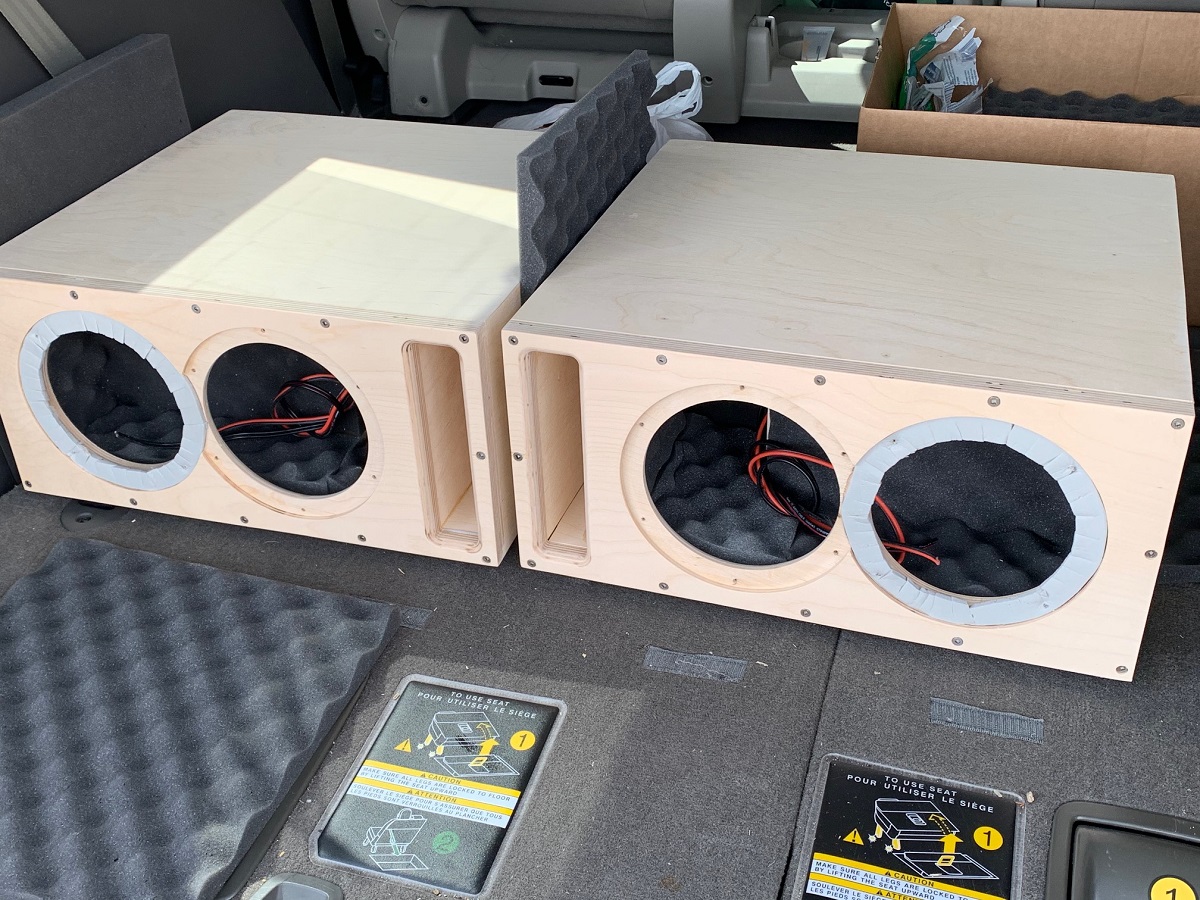

Attachments
I just noticed that member Augerpro has open source 3D files for the RST28F waveguide.
Dayton RST28 | somasonus
I just got a new Dremel Digilab 3D45 printer - test print looks awesome and very plug and play. No settings to adjust as filament is proprietary and has RFID to auto setup correctly for different materials/colors.
You can see my new printer making its first test object here:
Login • Instagram
Dayton RST28 | somasonus
I just got a new Dremel Digilab 3D45 printer - test print looks awesome and very plug and play. No settings to adjust as filament is proprietary and has RFID to auto setup correctly for different materials/colors.
You can see my new printer making its first test object here:
Login • Instagram
- Home
- Loudspeakers
- Multi-Way
- Simple Passive Harsch XO Using PTT6.5 and RS28F in a Waveguide
